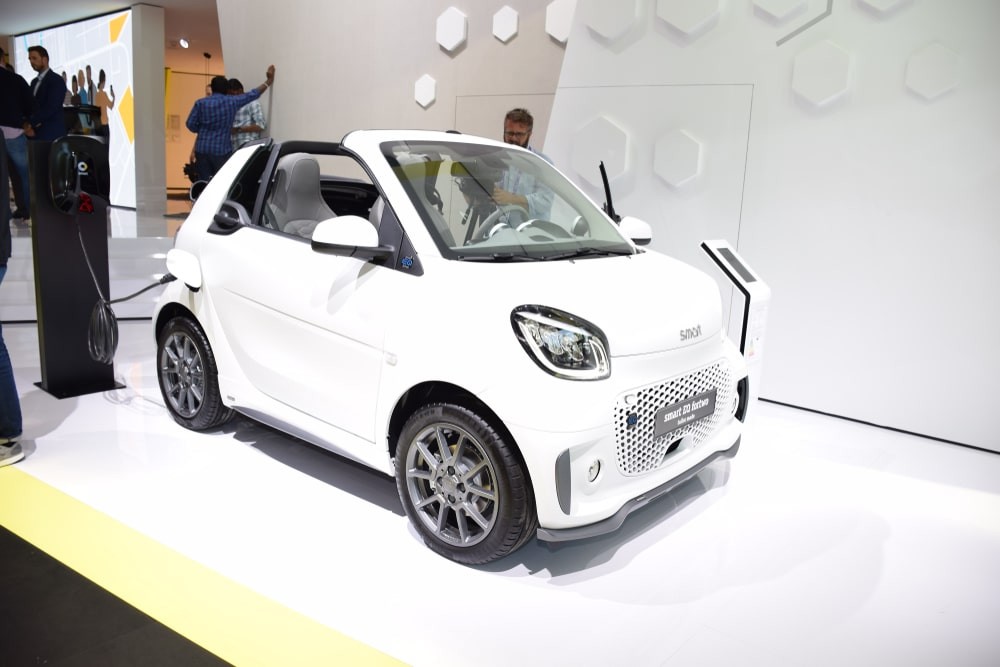Electric cars are rapidly gaining popularity, but many potential buyers still worry about their range. At SIXT.VN, we understand these concerns and aim to provide you with comprehensive information and convenient travel solutions in Vietnam. So, how far can an electric vehicle (EV) really go on a single charge? The driving range of an electric car depends on various factors, including battery capacity, driving habits, and weather conditions. Let SIXT.VN help you navigate Vietnam with confidence, offering reliable transportation, airport transfers, and comfortable accommodations. Explore Vietnam with peace of mind, knowing your travel needs are covered with our diverse range of travel alternatives.
1. Understanding Electric Vehicle Range: What Is the Average?
The average electric vehicle can travel approximately 348 km (216 miles) on a single charge, based on data from December 2022. However, this number varies significantly depending on the specific model, battery condition, driving style, and environmental factors.
Electric car range depends on various factors, so there’s no single answer. The range is affected by the vehicle model, battery condition, driving style, and weather. According to research from the US Environmental Protection Agency in 2019, the range of electric vehicles has improved dramatically, increasing from 100-150 km (63-94 miles) in 2011 to over 348 km (216 miles) today. SIXT.VN ensures that your Vietnamese adventure is hassle-free with services that consider these variables, offering optimized routes and dependable transportation options.
2. Which Electric Car Has the Longest Range?
The Lucid Air Dream Edition (Range Edition) currently boasts the longest range, estimated at 685 km (425 miles) under moderate driving conditions.
The Lucid Air Dream Edition stands out with its impressive range, achieving approximately 685 km (425 miles) under typical driving conditions. However, it’s important to note that factors like weather and driving style can significantly influence this range. For example, the Lucid Air Dream can achieve up to 960 km (596 miles) in city driving under mild conditions, but only around 505 km (313 miles) on the highway in cold weather. SIXT.VN provides dependable transportation, ensuring you reach your destination comfortably.
-min.jpg)
Alt: Lucid Air Dream Edition showcased at an auto show, emphasizing its innovative design and long-range capabilities.
3. Top 5 Electric Vehicles with the Longest Ranges
Here’s a quick overview of the top 5 electric car models with the longest ranges:
| Rank | Model | Range |
|---|---|---|
| 1 | Lucid Air Dream Edition | 645 – 685 km (401 – 425 miles) |
| 2 | Lucid Air Grand Touring | 665 km (413 miles) |
| 3 | Mercedes EQS | 565 – 640 km (351 – 397 miles) |
| 4 | Tesla Model S | 550 – 570 km (342 – 354 miles) |
| 5 | Lucid Air Pure | 560 km (348 miles) |
Disclaimer: Range based on moderate driving style and climate conditions, real-life values may differ significantly. Data from EV Database.
4. What Is the Electric Car with the Shortest Range?
The Smart EQ fortwo Cabrio has one of the shortest ranges among electric vehicles, offering approximately 95 km (59 miles) on a single charge.
The Smart EQ fortwo Cabrio is designed as a city car, offering a shorter range of approximately 95 km (59 miles). Despite its limited range, it charges quickly, taking only 55 minutes at 22 kW. These small EVs are agile, economical, and easy to park. SIXT.VN offers a variety of services to ensure seamless and enjoyable travel experiences in Vietnam, regardless of vehicle range considerations.
 A white Smart EQ fortwo cabrio parked at a tradeshow.
A white Smart EQ fortwo cabrio parked at a tradeshow.
Alt: Smart EQ fortwo Cabrio displayed at an automotive event, highlighting its compact size and suitability for urban driving.
5. How Has the Range of Electric Vehicles Improved Over Time?
Electric vehicle range has significantly increased. The Nissan LEAF, a popular early EV, had a maximum range of about 160 km (100 miles). The 2023 Nissan Leaf now offers up to 341 km (212 miles).
Battery technology advancements have driven improvements in EV range. The original Nissan LEAF had a range of 160 km (100 miles), while the 2023 model reaches 341 km (212 miles). Models like the Hyundai Kona, Volkswagen ID.4, and Kia EV6 now offer ranges between 400-500 km (249-310 miles). According to a Reuters report in 2022, battery prices have fallen significantly, making EVs more affordable and efficient. SIXT.VN is dedicated to making your travel experience in Vietnam as smooth and stress-free as possible.
6. What Factors Affect the Driving Range of Electric Vehicles?
Several factors influence how far an electric car can travel on a single charge:
- Driving Speed: High speeds and aggressive acceleration drain the battery faster.
- Temperature: Cold weather reduces battery performance.
- Electrical-Powered Features: Using heating, cooling, and other electrical features consumes more energy.
Several factors influence the range of electric vehicles. Driving speed, temperature, and use of electrical-powered features like heating and cooling affect the distance an EV can travel. For example, Renault offers a tool for its ZOE e-Tech Electric, allowing users to input driving conditions to see how battery capacity changes. SIXT.VN helps you plan your journey effectively by providing dependable transportation services and useful information, ensuring a seamless and enjoyable travel experience.
 A shot taken from the inside of a vehicle while driving on a highway during sun set.
A shot taken from the inside of a vehicle while driving on a highway during sun set.
Alt: Sunset view from inside an electric car driving on a highway, symbolizing efficient and enjoyable long-distance travel.
7. What Is Considered a Good Electric Vehicle Range?
A good EV range depends on your driving needs. The range is a key consideration for potential EV buyers.
The best EV range is one that meets your specific driving needs. Many potential EV buyers consider range a key factor before investing. According to the EVBox Mobility Monitor report in 2022, range anxiety is a significant concern for many drivers. In the US, the average driver travels about 21,687 km (13,476 miles) per year, or roughly 59.5 km (37 miles) per day. In Europe, daily averages vary, with Germans driving approximately 19 km (11 miles) and Greeks as little as 5.6 km (3.4 miles). SIXT.VN is here to assist, providing dependable transportation solutions and tailored travel support to enhance your experience.
 A man wearing a casual outfit standing next to his car on his driveway with a charging cable in hand.
A man wearing a casual outfit standing next to his car on his driveway with a charging cable in hand.
Alt: A man charging his electric car at home, highlighting the convenience and ease of EV ownership and daily use.
8. Understanding Driving to Empty (DTE) in Electric Vehicles
DTE, or Driving to Empty, is an estimate of how far you can drive with the remaining charge in an EV battery.
DTE is a critical metric for EV drivers, estimating the distance you can travel before the battery is depleted. This moving average is based on driving history, current charge, and conditions. Unlike gasoline cars, EVs require towing to a charging station when the battery is empty. Many EVs have features to prevent this, such as warnings when near a charging station. For instance, the Nissan Leaf enters “Turtle Mode,” slowing to 50 km/h (30 mph) to allow drivers to reach a safe spot. SIXT.VN helps ensure a smooth journey by offering comprehensive travel support and convenient transportation options.
9. Do Electric Car Batteries Lose Range Over Time?
Yes, EV batteries degrade over time, but the loss is gradual. Most EV batteries last between 15-20 years or 160,000 to 320,000 km (100,000 to 200,000 miles).
EV batteries gradually lose capacity, with an average decline of about 2.3% per year. For example, an EV with a 350 km (217 miles) range might lose about 40 km (24 miles) after five years. Many manufacturers offer warranties of eight to ten years, exceeding the usual warranty for combustion engines. According to Forbes in 2022, EV batteries are lasting longer than predicted. SIXT.VN ensures a worry-free travel experience with dependable services and support.
 A guy smiling at his phone while standing next to his electric car that is charging.
A guy smiling at his phone while standing next to his electric car that is charging.
Alt: A man checking his phone while his electric car charges, emphasizing the growing infrastructure and convenience of public EV charging stations.
10. Maximizing Electric Vehicle Range: Tips and Tricks
- Drive Efficiently: Avoid aggressive acceleration and high speeds.
- Maintain Optimal Tire Pressure: Proper inflation reduces rolling resistance.
- Use Regenerative Braking: This feature captures energy during deceleration.
- Precondition the Cabin: Heat or cool the car while it’s still plugged in.
- Minimize Electrical Loads: Limit the use of heating, cooling, and accessories.
11. How Does Temperature Affect Electric Car Range?
Cold temperatures can significantly reduce electric car range. In cold weather, the battery’s chemical reactions slow down, reducing its capacity and efficiency.
Cold weather can reduce EV battery capacity and efficiency. In colder temperatures, chemical reactions within the battery slow down, impacting overall performance. Preconditioning the battery and cabin while plugged in can help mitigate these effects. According to research, extreme temperatures can reduce EV range by as much as 40%. SIXT.VN offers reliable transportation services and helpful travel information to ensure you have a smooth and comfortable journey.
12. The Future of Electric Vehicle Range: What to Expect?
Battery technology is continually improving, leading to increased range and faster charging times.
Advances in battery technology promise increased range and faster charging times for EVs. Solid-state batteries, for example, could double energy density, significantly boosting range. According to the U.S. Department of Energy, ongoing research focuses on improving battery materials and designs to enhance EV performance and affordability. SIXT.VN remains committed to providing top-notch service and ensuring your travel experience is as enjoyable and convenient as possible.
13. Can Electric Cars Travel Long Distances?
Yes, electric cars can travel long distances, especially with the latest models offering ranges over 500 km (310 miles).
Modern electric cars are increasingly capable of long-distance travel, with many models offering ranges exceeding 500 km (310 miles). Tesla’s Supercharger network and other fast-charging stations are expanding, making long journeys more feasible. According to the Alternative Fuels Data Center, there are thousands of public charging stations across the United States, and the number is growing. SIXT.VN ensures your journey is smooth and stress-free by offering reliable transportation and comprehensive travel solutions.
14. What Is the Impact of Highway Driving on Electric Car Range?
Highway driving typically reduces electric car range due to higher speeds and less regenerative braking.
Highway driving affects EV range due to higher speeds and reduced regenerative braking. EVs are more efficient at lower speeds and in city environments where regenerative braking can recharge the battery. Tests have shown that highway driving can reduce EV range by 20-30%. SIXT.VN helps you optimize your travel plans with dependable services and valuable insights, ensuring a seamless and enjoyable experience.
15. How Does Regenerative Braking Work and How Does It Affect Range?
Regenerative braking captures energy during deceleration, converting it back into electricity to recharge the battery. This feature is especially effective in city driving, where frequent stops and starts are common.
Regenerative braking captures energy during deceleration, converting it into electricity to recharge the battery, enhancing efficiency, particularly in city driving. By using regenerative braking, drivers can extend their range by as much as 10-15% in urban settings. SIXT.VN ensures a seamless and enjoyable travel experience with dependable services and support, helping you make the most of your journey.
16. What Are the Different Types of Electric Car Charging?
There are three main levels of electric car charging:
- Level 1: Standard household outlet (slowest charging speed).
- Level 2: Dedicated charging station (faster than Level 1).
- Level 3 (DC Fast Charging): High-speed charging (fastest charging speed).
17. How Long Does It Take to Charge an Electric Car?
Charging time varies depending on the charging level and battery capacity:
- Level 1: Can take 20+ hours for a full charge.
- Level 2: Typically takes 4-8 hours for a full charge.
- Level 3: Can charge up to 80% in 30-60 minutes.
18. What Is Range Anxiety and How Can It Be Overcome?
Range anxiety is the fear of running out of battery power before reaching a charging station. It can be overcome by:
- Planning Routes: Knowing where charging stations are located.
- Monitoring Battery Level: Keeping track of remaining range.
- Driving Efficiently: Conserving energy to extend range.
19. Electric Car Range vs. Fuel Efficiency: A Comparison
Electric cars are generally more efficient than gasoline cars. They convert a higher percentage of energy into motion, resulting in lower operating costs.
Electric cars are generally more efficient than gasoline cars, converting a higher percentage of energy into motion. EVs also have lower operating costs due to reduced maintenance and fuel expenses. According to the U.S. Department of Energy, EVs can save drivers thousands of dollars in fuel costs over the vehicle’s lifespan. SIXT.VN is dedicated to ensuring your travel experience in Vietnam is as smooth and enjoyable as possible.
20. How to Find Electric Car Charging Stations in Vietnam
Finding EV charging stations in Vietnam involves:
- Using Mobile Apps: Apps like PlugShare and ChargePoint list available stations.
- Checking Online Maps: Google Maps and other online maps often show charging locations.
- Consulting with Hotels and Businesses: Many offer charging stations for customers.
FAQ About Electric Car Range
How accurate are electric car range estimates?
Range estimates are generally accurate but can vary based on driving conditions and habits.
Can I extend my electric car’s range while driving?
Yes, by driving efficiently, using regenerative braking, and minimizing electrical loads.
Do all electric cars have regenerative braking?
Most modern electric cars feature regenerative braking to improve efficiency.
How often should I charge my electric car?
It depends on your daily driving needs, but topping up regularly can help maintain battery health.
Is it better to fully charge an electric car or charge it partially?
Partial charging is generally better for long-term battery health.
What happens if an electric car runs out of charge?
The car will stop, and you’ll need to have it towed to a charging station.
Are there any government incentives for buying electric cars?
Many governments offer incentives like tax credits and rebates to encourage EV adoption.
Do electric cars require special maintenance?
Electric cars generally require less maintenance than gasoline cars, with fewer moving parts.
Can I charge an electric car at home?
Yes, you can charge an electric car at home using a standard outlet or a Level 2 charger.
How much does it cost to charge an electric car?
The cost varies depending on electricity rates and the charging level used.
SIXT.VN: Your Premier Travel Partner in Vietnam
Planning a trip to Vietnam and need reliable transportation and travel assistance? SIXT.VN offers a comprehensive range of services to make your journey seamless and enjoyable:
- Airport Transfers: Start your trip stress-free with our dependable airport transfer services.
- Hotel Booking: Find the perfect accommodations to suit your needs and budget.
- Sightseeing Tours: Discover the best of Hanoi and beyond with our expertly guided tours.
- Flight Booking: Get the best deals on flights to and from Vietnam.
SIXT.VN is committed to providing top-notch service and ensuring your travel experience is as smooth and enjoyable as possible. Our dedication to quality and customer satisfaction makes us the ideal partner for your Vietnamese adventure.
Ready to experience the best of Vietnam? Contact SIXT.VN today to book your airport transfer, hotel, tour, or flight!
Address: 260 Cau Giay, Hanoi, Vietnam
Hotline/WhatsApp: +84 986 244 358
Website: SIXT.VN
Let SIXT.VN take the stress out of your travel planning, so you can focus on creating unforgettable memories in Vietnam. We look forward to welcoming you!



